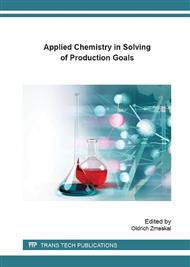[1]
J.L. Provis, J.S.J. van Deventer, Alkali Activated Materials, New York, 2014, ISBN 978-94-007-7671-5.
Google Scholar
[2]
C. Wu, Y. Zhang, Z. Hu, Properties and application of alkali-slag cement, Journal of the Chinese Cement Society 21 (1993), 176–181.
Google Scholar
[3]
C.L. Nicholson, B.J. Murray, R.A. Fletcher, D.R.M. Brew, K.J.D. MacKanzie, M. Schmücker, Novel geopolymer materials containing borate structural units, World Congress Geopolymer (2005), 31–35.
Google Scholar
[4]
A.R. Brough, M. Holloway, J. Sykes, A. Atkinson, Sodium silicate-based alkali-activated slag mortars. Part II. The retarding effect of additions of sodium chloride or malic acid, Cem. Concr. Res. 30 (2000), 1375–1379.
DOI: 10.1016/s0008-8846(00)00356-2
Google Scholar
[5]
J.J. Chang, W. Yeih, C.C. Hung, Effects of gypsum and phosphoric acid on the properties of sodium silicate-based alkali-activated slag pastes, Cem. Concr. Com. 27 (2005), 85–91.
DOI: 10.1016/j.cemconcomp.2003.12.001
Google Scholar
[6]
C. Gong, N. Yang, Effect of phosphate on the hydration of alkali-activated red mud slag cementitious material, Cem. Concr. Res. 30 (2000), 1013–1016.
DOI: 10.1016/s0008-8846(00)00260-x
Google Scholar
[7]
C. Shi, Y. Li, Investigation on some factors affecting the characteristics of alkali-phosphorus slag cement, Cem. Concr. Res. 19 (1989), 527–533.
DOI: 10.1016/0008-8846(89)90004-5
Google Scholar
[8]
W.K.W. Lee, J.S.J. van Deventer, Effects of anions on the formation of aluminosilicate gel in geopolmyers, Ind. Eng. Chem. Res. 41 (2002), 4550–4558.
DOI: 10.1021/ie0109410
Google Scholar
[9]
C. Shi, R.L. Day, A calorimetric study of early hydration of alkali-slag cements, Cem. Concr. Res. 25 (1995), 1333–1346.
DOI: 10.1016/0008-8846(95)00126-w
Google Scholar
[10]
B.A. Averill, P. Eldredge, Principles of general chemistry, Prentice Hall, 2007, ISBN 0-8053-3799-7.
Google Scholar
[11]
D.A. Kulik, M. Kersten, Aqueous solubility diagrams for cementitious waste stabilization systems: II, end-member stoichiometries of ideal calcium silicate hydrate solid solutions, J. Am. Cer. Soc. 84 (2001), 3017–3026.
DOI: 10.1111/j.1151-2916.2001.tb01130.x
Google Scholar


